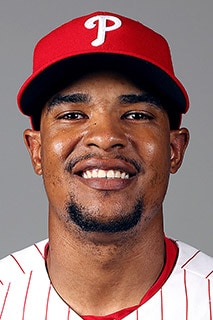

Imagine the feeling of that moment. Drafted in 2006, a third-round pick by the San Diego Padres, Hunter was labeled a prospect, an outfielder with potential. Bright lights, big plans. He was quickly sent to triple-A at age 19, then back down to single-A at age 20. A few years later he was back in triple A, hitting well enough to keep a starting job in Tucson, but not well enough to earn a call-up for San Diego.
He finally earned the call-up in 2011, but for just six games. He collected one hit and one walk. Then he was gone, back to triple-A and soon, waived by the Padres, a victim of roster management.
He went to Oakland after 2011, but before 2012 was dealt to St. Louis. Then a free agent. Then with Cleveland in 2013. Then a free agent. Then with Atlanta in 2014 and ‘15. A free agent once more. Never a major leaguer.
The Phillies signed Hunter in January and booked him for spring training. He performed well enough to make the 25-man roster and, suddenly, found himself in the opening day batting order. Three days later, against Stephenson, he hit his first home run, a moment possible because he stayed in the game, kept chasing his dream, thought maybe someone could use him and want him and give him an opportunity.
Hunter isn’t starting today for the Phillies, shelved because the Padres are starting left-handed pitcher Robbie Erlin. It’s a good day for Hunter to rest, because – statistically – it’s likely he’s been the Phillies’ worst offensive player.
In 22 plate appearances over seven games, Hunter is hitting .095 with a .136 on-base percentage and .238 slugging percentage. He has the home run, but otherwise just a single. He has walked once and struck out four times.
Hunter has been swinging a lot. Thus far he has swung at nearly 50 percent of the pitches he’s seen (49.4%). When he does, though, he makes contact a fair amount of time (93% of pitches in the zone; 60% of pitches outside of the zone). So he can get to the ball, and Monday he demonstrated that enough, swinging at pitches slightly higher in the zone. One of those balls nearly sailed out to the opposite field, while another was struck for a clean line-grounder, but was hit right into the shift.
One may surmise Hunter is showing some classic signs of early jitters. This is a guy who hasn’t ever had serious time starting for a major league team. He’s possibly feeling all of the stressors felt by normal 22- and 23-year-old players upon their first call-ups, as it’s been so long since he’s made it to the majors. Add to that the pressure of having to succeed immediately, since he’s 28 and no longer a “prospect,” and thus won’t have as long a leash. Add to that the probable, very common excitement of starting a new season – and showing yourself off to a new team with new players, new coaches and new environs – and you have a potent mixture occurring inside Hunter in early April.
I would even bet that while his first home run could’ve been a release of those stressors, it could’ve also been intensifying the stress. Maybe Hunter wants to continuously prove he has the power to be a mid-lineup force.
We don’t know, and we probably won’t ever know, what is going on with Cedric Hunter or any player at any time, so yes, there’s a fair amount of spit-balling here. But it’s always good to give a new player a day or two off once in awhile. He could certainly use it, if only because of his numbers.
But watch his swing again – he connects well. And note his power – he nearly parked one the opposite way Monday. If Hunter’s extended look continues – and it shouldn’t be compromised by Pete Mackanin’s interest in giving Darin Ruf unnecessary outfield starts – it’s possible he could show the Phillies a whole lot more than what they’re seeing right now. There’s real potential in that player, potential that other teams may regret they never tapped into.